
- 3-D Nanofabrication
- Microfluidics
- Optical Device Fabrication
- Nonlinear Optics of Metal Nanostructures
- Nanoscale Cell Science
- Optical Manipulation of Nano/Microstructures
- Nonlinear Optical Spectroscopy of Liquids
- Confined Liquids
- Liquids at Interfaces
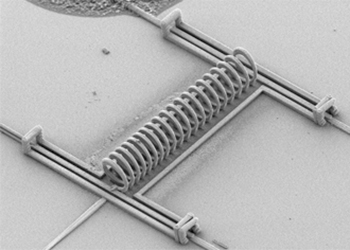 3-D Nanofabrication
3-D Nanofabrication
Nonlinear optical phenomena offer the capability of localizing photochemical and photophysical processes in regions that are smaller than the wavelength of the light employed. For instance, two-photon absorption allows photopolymerization to be localized within the focal volume of a tightly-focused laser beam, making it possible to fabricate arbitrarily complex, 3D polymeric micro and nanostructures. Development of technology for, and applications of, multiphoton absorption polymerization is a major focus of our research. We have recently developed a technique called Resolution Augmentation through Photo-Induced Deactivation (RAPID) photolithography that makes it possible to create polymeric features that are as small as 40 nm (1/20 of the wavelength of light employed).
Representative publications:
“Nanoscale Photolithography with Visible Light,” John T. Fourkas, J. Phys. Chem. Lett 1, 1221-1227 (2010)
"Achieving lambda/20 Resolution by One-Color Initiation and Deactivation of Polymerization," Linjie Li, Rafael R. Gattass, Erez Gershgoren, Hana Hwang and John T. Fourkas, Science 324, 910-913 (2009).
"Recent Progress in Multiphoton Fabrication ," Shoji Maruo and John T. Fourkas, Laser and Photonics Rev. 2, 100-111, (2008).
"Multiphoton Fabrication ," Christopher N. LaFratta, John T. Fourkas, Tommaso Baldacchini and Richard A. Farrer, Angew. Chem. Int. Ed. 46, 6238 - 6258 (2007).
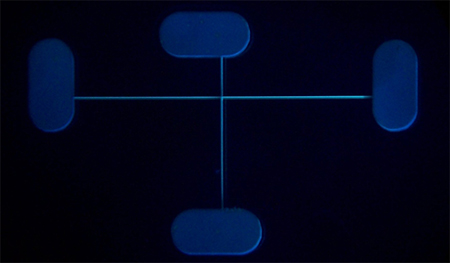 Microfluidics
Microfluidics
Microfluidic systems, which process small volumes (microliters to nanoliters) of fluids, are generally fabricated using the same techniques employed to make MicroElectroMechanical Systems (MEMS) and microelectronic devices. For example, one strategy for producing a microfluidic device involves the microfabrication of a master structure that is subsequently used to create an elastomeric polymer mold (e.g. polydimethylsiloxane mold) via soft lithography (e.g. microtransfer molding). We are pursuing the use of multiphoton fabrication to create novel microfluidic devices. The use of multiphoton fabrication allows us to create microfluidic systems that would be difficult or impossible to fabricate with conventional techniques, allowing us to introduce novel functionality.
Representative publications:
“High-Speed Multiphoton Absorption Polymerization: Fabrication of Microfluidic Channels with Arbitrary Cross-Sections and High Aspect Ratios,” George Kumi, Ciceron O. Yanez, Kevin D. Belfield and John T. Fourkas, Lab Chip 10, 1057-1060 (2010).
.jpg) Optical Device Fabrication
Optical Device Fabrication
Multiphoton Absorption Polymerization (MAP) can be used to make high-quality, polymeric structures with low surface roughness. These attributes, along with the ability to create 3D structures and to incorporate additional materials, makes MAP a powerful technique for the fabrication of optical devices. We are using MAP to create both passive and active optical devices for applications such as signal processing and sensing.
Representative publications:
“Fabrication of High-Performance Optical Devices Using Multiphoton Absorption Polymerization,” Linjie Li, Rafael Gattass, George Kumi, Erez Gershgoren, Wei-Yen Chen, P.-T. Ho, Warren N. Herman and John T. Fourkas, in Organic Thin Films for Photonic Applications (American Chemical Society, Washington, DC, 2010), Warren N. Herman, Steven R. Flom, and Stephen H. Foulger, eds.; pp. 129-137.
"High Performance Microring Resonators Fabricated with Multiphoton Absorption Polymerization," Linjie Li, Erez Gershgoren, George Kumi, Wei-Yen Chen, P.-T. Ho, Warren N. Herman and John T. Fourkas, Adv. Mater. 20, 3668-3671 (2008)
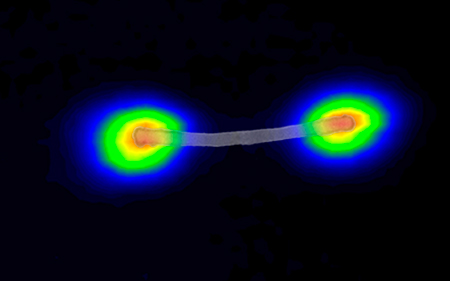 Nonlinear Optics of Metal Nanostructures
Nonlinear Optics of Metal Nanostructures
Noble-metal nanostructures have the ability to enhance optical-frequency electric and magnetic fields by many orders of magnitude. For ultrafast pulses, field enhancement makes a wide range of nonlinear optical phenomena possible at relatively low average powers. We are interested in field-enhanced, nonlinear optical phenomena such as Multiphoton-Absorption-Induced Luminescence (MAIL) and Metal-Enhanced Multiphoton Absorption Polymerization (MEMAP). In addition to studying the relationships among different field-enhanced phenomena of noble-metal nanostructures, we are also interested in their applications in areas such as biological imaging and nanofabrication.
Representative publications:
“Metal-Enhanced Multiphoton Absorption Polymerization with Gold Nanowires,” Sanghee Nah, Linjie Li, Ran Liu, Junjie Hao, Sang Bok Lee and John T. Fourkas, J. Phys. Chem. C 114, 7774–7779 (2010).
"Field-Enhanced Phenomena of Gold Nanoparticles," Sanghee Nah, Linjie Li and John T. Fourkas, J. Phys. Chem. A 113, 4416–4422 (2009).
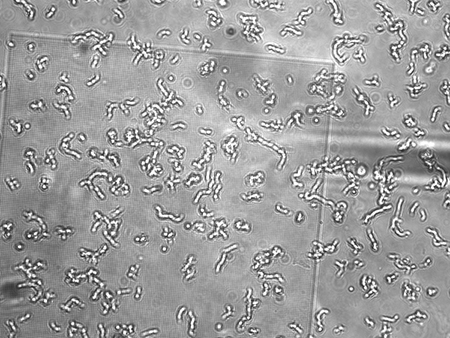 Nanoscale Cell Science
Nanoscale Cell Science
Nanoscale structures and chemical patterns can influence the behavior of cells. We are using microscale and nanoscale patterning with multiphoton absorption polymerization, and other techniques, to explore and control the motility of Dictyostelium discoideum, a model system for the study of cellular migration.
Representative publications:
"Binary and Gray-Scale Patterning of Chemical Functionality on Polymer Films," Linjie Li, Meghan Driscoll, George Kumi, Ronald Hernandez, Karen J. Gaskell, Wolfgang Losert, and John T. Fourkas , J. Amer. Chem. Soc. 130, 13512-13513 (2008); (communication)
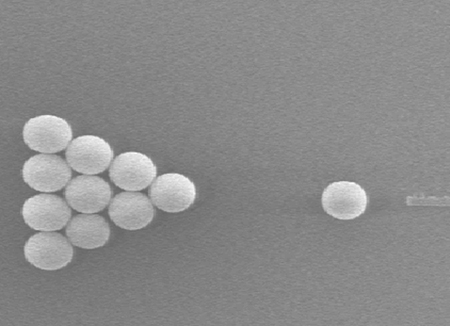 Optical Manipulation of Nano/Microstructures
Optical Manipulation of Nano/Microstructures
Optical manipulation holds great promise for applications ranging from the fabrication of micro and nanostructures to the actuation of microscopic devices. We are developing new chemistries and new techniques that combine multiphoton absorption polymerization with optical manipulation for the wide range of new applications in nanotechnology.
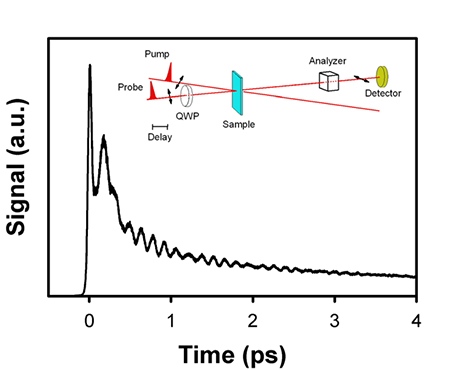 Nonlinear Optical Spectroscopy of Liquids
Nonlinear Optical Spectroscopy of Liquids
We have a longstanding interest in the application of nonlinear optical spectroscopies to probe the microscopic structure and dynamics of liquids. We employ techniques such as optical Kerr effect spectroscopy to study diffusive reorientation and other microscopic dynamics in bulk liquids, and to connect dynamic observables to molecular and intermolecular structure. We are also interested in the development of new nonlinear optical methods for studying liquids, as well as in the theory of nonlinear optical spectroscopies in liquids.
Representative publications:
"Optical Kerr Effect Spectroscopy of Simple Liquids," Qin Zhong and John T. Fourkas, J. Phys. Chem. B 112, 15529–15539 (2008) (Centennial Feature Article)
"Shape and Electrostatic Effects in Optical Kerr Effect Spectroscopy of Aromatic Liquids," Qin Zhong and John T. Fourkas, J. Phys. Chem. B 112, 15342–15348 (2008)
"Searching for Voids in Liquids with Optical Kerr Effect Spectroscopy, " Qin Zhong and John T. Fourkas, J. Phys. Chem. B 112, 8656-8663 (2008).
"Antiresonant-Ring Kerr Spectroscopy," Qin Zhong, Xiang Zhu and John T. Fourkas, Opt. Exp. 15, 6561-6568 (2007).
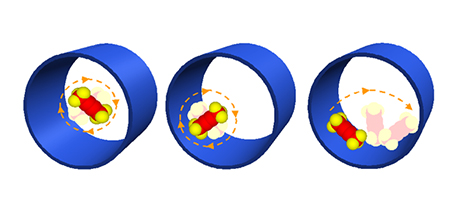 Confined Liquids
Confined Liquids
Confinement on a distance scale that is comparable to a few molecular diameters can have profound effects on the chemical and physical properties of liquids. We use microporous, silica sol-gel glasses to perform optical spectroscopy on confined liquids. These materials allow us to control both the pore diameter and the surface chemistry, allowing us to develop a detailed understanding of the physical and chemical effects that influence the behavior of confined liquids.
Representative publications:
“Optical Spectroscopy of Liquids in and Near Inorganic Oxides,” John T. Fourkas, in Spectroscopic Properties of Inorganic and Organometallic Compounds, (RSC Publishing, Cambridge, UK, 2009), Jack Yarwood, Richard Douthwaite and Simon B. Duckett, eds.; pp. 150-170.
"Ultrafast Orientational Dynamics of Nanoconfined Benzene," Xiang Zhu, Richard A. Farrer and John T. Fourkas, J. Phys. Chem. B 109, 12724 (2005).
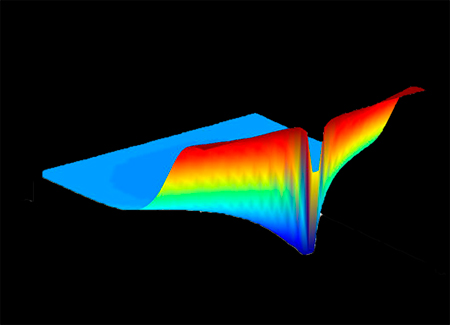 Liquids at Interfaces
Liquids at Interfaces
The behavior of a liquid at an interface can differ markedly from the behavior of the same liquid in the bulk. The forces between the surface and the liquid compete with the forces among the liquid molecules, leading to changes in the local structure and dynamics of the liquid. We are using techniques such as vibrational sum-frequency-generation spectroscopy and contact-angle measurements to study liquids at oxide interfaces. We are also developing new nonlinear optical spectroscopies for studying interfacial liquids, as well as new theoretical treatments for understanding the information available from existing nonlinear optical techniques.
Representative publications:
“Behavior of Organic Liquids at Bare and Modified Silica Interfaces,” Pearl Horng, Michael R. Brindza Robert A. Walker and John T. Fourkas, J. Phys. Chem C. 114, 394-402 (2010).
"Ti:sapphire, Broadband Vibrational Sum Frequency Generation Spectrometer with a Counter-Propagating Geometry," Feng Ding, Qin Zhong, Michael R. Brindza, John T. Fourkas, and Robert A. Walker, Opt. Expr. 17, 14665–14675 (2009).
"Effects of Reorientation in Vibrational Sum Frequency Spectroscopy," John T. Fourkas, Robert A. Walker, Suleyman Can and Erez Gershgoren, J. Phys. Chem. C 111, 8902-8915 (2007).
